The Pacific Loon, scientifically known as Gavia pacifica, is a captivating bird species found in the northern regions of North America.
With its sleek, streamlined body and striking plumage, the Pacific Loon is renowned for its remarkable diving abilities and haunting vocalizations.
During the breeding season, these birds inhabit freshwater lakes and ponds, engaging in elaborate courtship displays to attract mates.
Outside the breeding season, they migrate to coastal waters, including bays, estuaries, and offshore areas, where they forage for small fish and crustaceans.
Despite habitat loss and pollution threats, the Pacific Loon continues to thrive, captivating bird enthusiasts and researchers with its enigmatic behavior and mysterious migrations.
Understanding the biology and ecology of the Pacific Loon is essential for conserving this iconic bird and ensuring its survival for future generations to admire and study. Stay sharp.
How to Identify Pacific Loon?
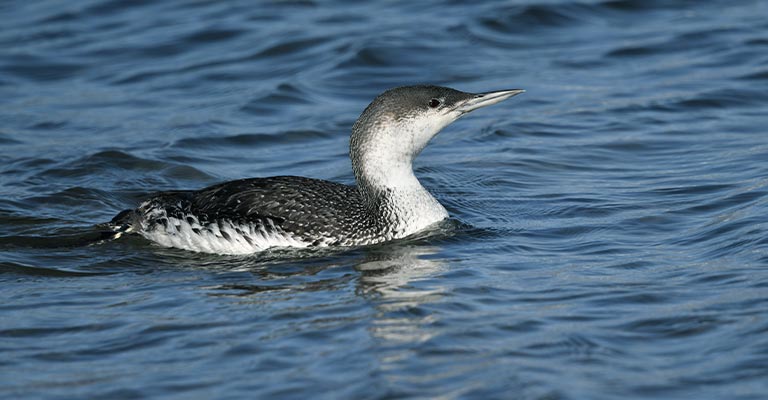
The Pacific Loon, known scientifically as Gavia pacifica, is a distinctive species of bird commonly found in the northern regions of North America during its breeding season.
Understanding this bird’s key characteristics and behaviors is crucial to identify it in its natural habitat accurately. Here are some of the points to help you determine the Pacific Loon:
Size and Shape
Pacific Loons are medium-sized birds, measuring around 24-28 inches long, with a wingspan of approximately 45 inches.
They have a sleek, streamlined shape with a long body and neck, aiding their swift underwater movements while hunting for fish.
Plumage
During the breeding season, Pacific Loons exhibit a striking appearance with a glossy, iridescent black head and neck.
The back and wings are a contrasting dark gray, while the underparts are white. Outside the breeding season, their plumage becomes more subdued, with a mottled gray pattern on the head and neck.
Bill
One of the distinguishing features of the Pacific Loon is its bill, which is relatively long, slender, and slightly upturned. The black bill contrasts sharply with the bird’s pale facial markings.
Facial Pattern
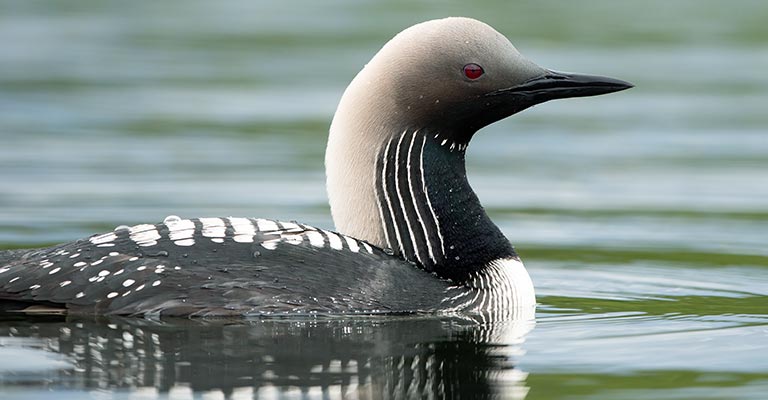
Look for the distinctive facial pattern of the Pacific Loon, which includes a white patch on the throat and chin that extends up to the eye, contrasting with the dark plumage of the head.
This white patch helps to differentiate it from similar loon species.
Voice
Like other loons, the Pacific Loon is known for its haunting calls, which consist of a series of wails and yodels.
These vocalizations are often heard during the breeding season and serve as territorial markers and communication between mates.
Behavior
Pacific Loons are skilled divers, capable of plunging underwater to depths of up to 200 feet in search of prey. They primarily feed on small fish, crustaceans, and aquatic invertebrates.
Watch for their diving behavior, which may involve brief periods of floating on the surface followed by sudden, rapid dives.
Habitat
During the breeding season, Pacific Loons inhabit freshwater lakes and ponds in the northern regions of North America, particularly in Alaska and northern Canada.
They migrate to coastal waters outside the breeding season, including bays, estuaries, and offshore areas.
Range
While the Pacific Loon’s breeding range is primarily confined to the northern regions of North America, during the winter months, they can be found along the Pacific coastlines of the United States and Mexico and in parts of Asia.
Examining its essential characteristics and behaviors, you can confidently identify the Pacific Loon in its natural habitat.
Whether you’re observing them during their breeding season in freshwater lakes or encountering them in coastal waters during migration, the Pacific Loon’s distinctive features make it a fascinating bird to observe and study.
Taxonomy of Pacific Loon
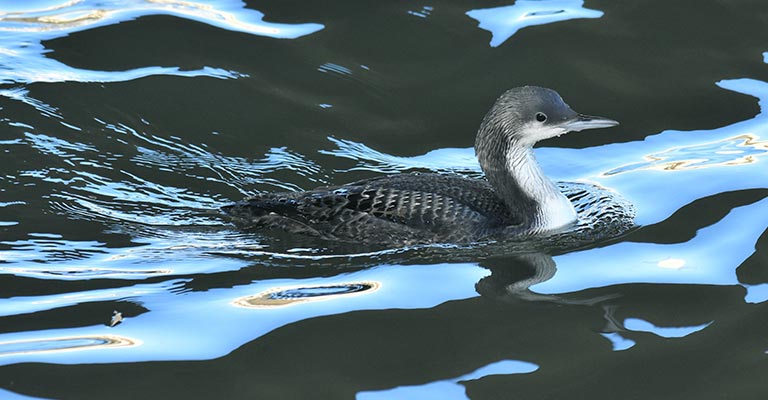
Get into the following table detailing the taxonomy details of the Pacific Loon:
| Taxonomic Rank | Classification |
| Domain | Eukaryota |
| Kingdom | Animalia |
| Phylum | Chordata |
| Class | Aves |
| Order | Gaviiformes |
| Family | Gaviidae |
| Genus | Gavia |
| Species | G. pacifica |
The Pacific Loon (Gavia pacifica) belongs to the family Gaviidae and the genus Gavia. It is a species of aquatic bird classified within the order Gaviiformes, which includes loons.
Loons are characterized by their streamlined bodies, webbed feet, and strong diving capabilities. They are further distinguished by their unique vocalizations and striking plumage patterns.
The taxonomy of the Pacific Loon reflects its evolutionary relationships with other loon species and provides insights into its ecological niche and behavior within its natural habitat.
Reproduction of Pacific Loon
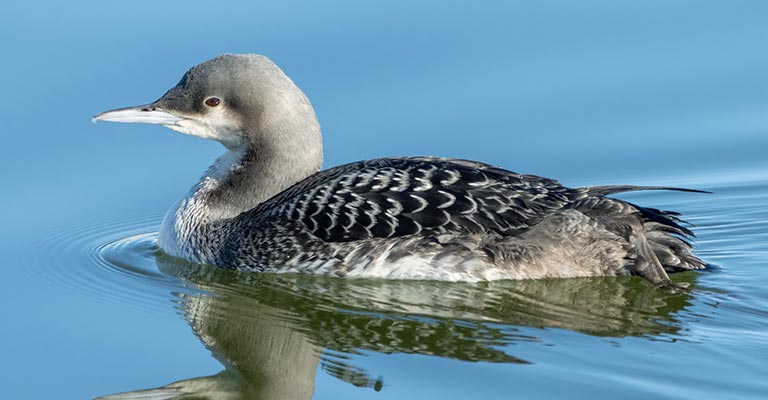
The reproduction process of the Pacific Loon typically begins in late spring to early summer. Males establish territories on freshwater lakes in the northern regions of North America, where they perform elaborate courtship displays to attract females.
Courtship displays may involve vocalizations, synchronized swimming, and displays of the striking breeding plumage.
Once paired, the male and female build a nest, usually a shallow depression lined with grasses and feathers near the water’s edge.
The female typically lays two eggs, which both parents take turns incubating for about three to four weeks. After hatching, the chicks are precocial, meaning they can leave the nest and swim shortly after birth.
Both parents share the responsibilities of feeding and protecting the chicks until they can fend for themselves, usually around seven to eight weeks old.
Pacific Loon Life History
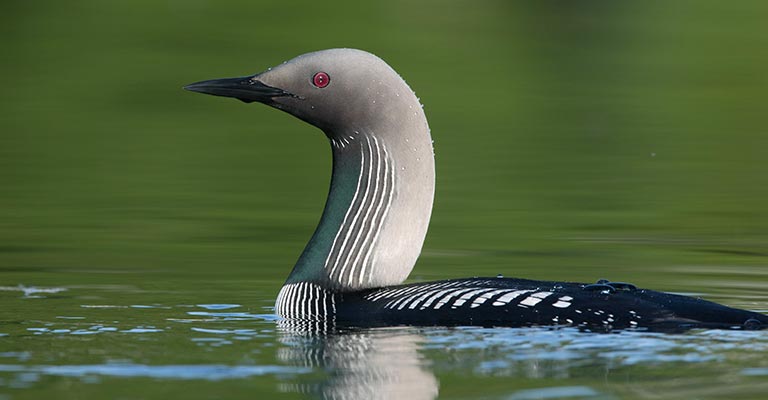
The Pacific Loon (Gavia pacifica) is a fascinating bird species native to the northern regions of North America.
Its life history encompasses various aspects, including food habits, habitat preferences, nesting behaviors, disease interaction, conservation status, and efforts to protect its populations.
Food
Pacific Loons primarily feed on small fish, crustaceans, and aquatic invertebrates. Their diet consists of species like smelt, stickleback, and shrimp, which they hunt by diving underwater.
Their streamlined bodies and webbed feet make them proficient underwater hunters, capable of diving to impressive depths to catch prey.
Habitat
During the breeding season, Pacific Loons inhabit freshwater lakes and ponds in northern regions, particularly Alaska and northern Canada.
They migrate to coastal waters outside the breeding season, including bays, estuaries, and offshore areas. They are also found in marine environments during winter migration.
Range Map
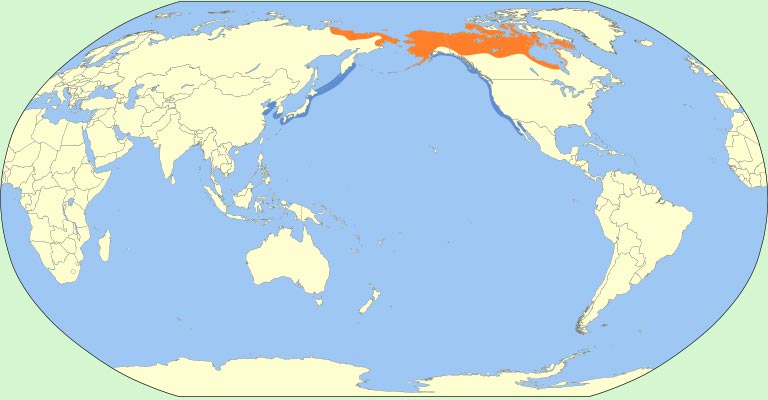
A range map depicts the distribution of Pacific Loons throughout their breeding and non-breeding seasons.
It highlights their migration routes, breeding grounds, and wintering areas, providing valuable information for conservation efforts and research.
Nesting
Pacific Loons build their nests near the water’s edge, typically on islands or marshy areas within their breeding territories. The nest is a shallow depression lined with grasses, feathers, and other vegetation.
Females usually lay two eggs, which both parents incubate for about three to four weeks. After hatching, the chicks are precocial and leave the nest shortly after birth.
Here’s a table outlining the nesting details of the Pacific Loon:
| Nesting Details | Facts |
| Clutch Size | Typically one brood |
| Number of Broods | Oval-shaped, pointed at one end; color varies from pale olive to brown with dark spots or blotches. |
| Egg Length | Approximately 3 inches |
| Egg Width | Approximately 2 inches |
| Incubation Period | About 3-4 weeks |
| Nestling Period | Around 7-8 weeks |
| Egg Description | Oval-shaped, pointed at one end; color varies from pale olive to brown with dark spots or blotches |
These nesting details provide insights into the reproductive biology of the Pacific Loon, highlighting aspects such as clutch size, incubation period, and egg characteristics.
Understanding these factors is crucial for conservation efforts aimed at protecting nesting habitats and ensuring the survival of this species.
Diseases and Treatment
Pacific Loons may face threats from diseases such as avian botulism and oil spills in their habitats.
Treatment for diseases often involves rehabilitation efforts by wildlife rescue organizations, including providing medical care and releasing affected individuals back into the wild.
Conservation
Conservation efforts for Pacific Loons focus on protecting their breeding and wintering habitats, reducing threats from pollution, oil spills, and bycatch in fishing gear, and monitoring population trends.
Collaboration between government agencies, conservation organizations, and local communities is crucial for ensuring the long-term survival of this species.
Understanding the life history of the Pacific Loon is essential for conserving its population and ensuring its continued presence in the ecosystems it inhabits.
By addressing threats to its habitat and implementing conservation measures, we can help safeguard this iconic bird for future generations.
10 Fun Facts About Pacific Loon
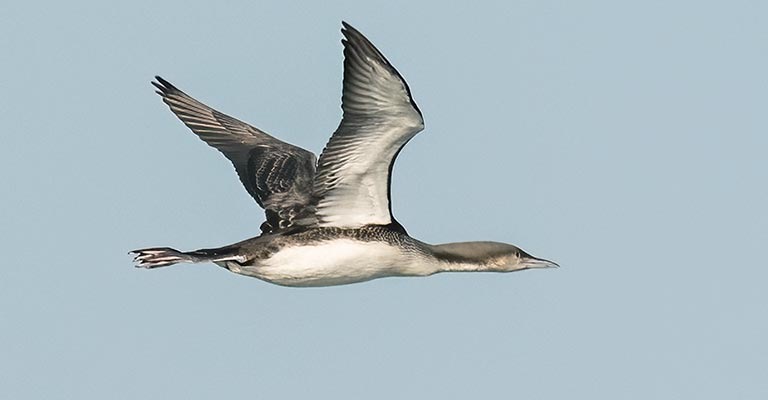
The Pacific Loon (Gavia pacifica) is a captivating bird species found in the northern regions of North America.
With its striking appearance and unique behaviors, the Pacific Loon offers many fascinating facts to explore.
- Diverse Plumage: Pacific Loons exhibit striking plumage variations throughout the year. During the breeding season, they sport glossy black heads and necks, while their winter plumage features a more subdued, mottled gray pattern.
- Elegant Divers: Known for their remarkable diving abilities, Pacific Loons can plunge to depths of up to 200 feet in search of prey. Their streamlined bodies and webbed feet make them adept underwater hunters.
- Territorial Calls: During the breeding season, Pacific Loons engage in vocal displays to establish territories and attract mates. Their haunting calls, consisting of wails and yodels, echo across the lakes and ponds of their breeding grounds.
- Migration Marvels: Pacific Loons embark on impressive migration journeys, traveling thousands of miles between their breeding and wintering grounds. They can be found along the Pacific coastlines of the United States and Mexico during winter.
- Precocial Chicks: Pacific Loon chicks are precocial, meaning they can leave the nest and swim shortly after hatching. Both parents share the responsibilities of feeding and protecting the chicks until they are independent.
- Feeding Frenzy: These birds primarily feed on small fish, crustaceans, and aquatic invertebrates. They often dive and forage in coastal waters, estuaries, and offshore areas.
- Nesting Rituals: Pacific Loons build their nests near the water’s edge, typically on islands or marshy areas. The nests are shallow depressions lined with grasses, feathers, and other vegetation.
- Conservation Concerns: Despite being relatively common, Pacific Loons face threats from habitat loss, pollution, and disturbances to their breeding grounds. Conservation efforts are crucial for protecting their populations and habitats.
- Social Behavior: Outside of the breeding season, Pacific Loons can be found in loose flocks on coastal waters. They often engage in social behaviors such as synchronized swimming and vocalizations.
- Mysterious Migrations: While scientists have gained insights into the migration patterns of Pacific Loons, many aspects of their migratory behavior remain shrouded in mystery, adding to their allure and intrigue.
From their stunning plumage to their remarkable diving abilities, the Pacific Loon is a captivating species worthy of admiration and study. These fun facts offer a glimpse into the fascinating world of this enigmatic bird.
Wrapping Up
So, the Pacific Loon is a remarkable bird species with its striking plumage, impressive diving abilities, and fascinating behaviors.
From its haunting calls during the breeding season to its mysterious migrations across vast distances, the Pacific Loon captivates bird enthusiasts and researchers alike.
By understanding its biology, nesting habits, and conservation needs, we can work together to ensure the long-term survival of this iconic bird. Thank you so much.